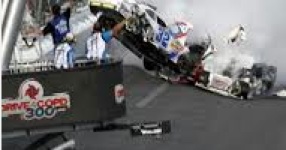


YouTube video/ A fan in the stand, David Ellsbury, shot this raw video of the tire that flew into the grandstands on the final lap heading to the finish line of the Feb. 23 Nationwide Race at Daytona International Speedway. NASCAR officials Wednesday announced plans to shore up fencing after fans were injured by flying debris in the February Speedweeks race held the day before the Daytona 500.
 Photo courtesy of NASCAR / A last lap crash sent cars careening and debris into the stands as shown here at the finish line.
Photo courtesy of NASCAR / A last lap crash sent cars careening and debris into the stands as shown here at the finish line.DAYTONA BEACH -- Joie Chitwood, president of Daytona International Speedway doesn't want a repeat of the crash on the super speedway in February that sent debris flying into the stands, including a tire that resulted in nearly 30 spectator injuries.
NASCAR officials announced earlier today plans to install additional cables at the crossover gates that allow fans to move between the grandstands and the infield before and after races.
Both super speedways will have additional supplemental tethers installed between the gate frame and support posts as well.
"We're pleased with the solution that we're implementing for Talladega and Daytona," Chitwood said, but was quick to add, "Fan safety is an ongoing process and we're going to continue to look at the fan experience across all our venues for future improvement as we continue through."
"We're pleased with the solution that we're implementing for Talladega and Daytona," Chitwood said, but was quick to add, "Fan safety is an ongoing process and we're going to continue to look at the fan experience across all our venues for future improvement as we continue through."
Nationwide rookie driver Kyle Larson's car broke apart on the final lap just before the finish line in a multi-car crash, ripping the vehicle in half as it became airborne, slammed against the fence and sent debris into the stands, including a tire that struck a racing fan.
The 19-year-old driver was unharmed, but more than two dozen fans were transported to local hospitals for care, though none were life threatening. The crash occurred the night before the Daytona 500, forcing track workers to work through the night to shore up the fencing in time for the Daytona 500 that had Danica Patrick on the pole, an historic first for a woman driver at a NASCAR-sanctioned race.
Five-time NASCAR Sprint Cup champion Jimmie Johnson ended up winning his second Daytona 500 with fan-favorite Dale Earnhardt Jr. finishing second for the second year in a row. Patrick finished in the top 10.
NASCAR officials were involved throughout the emergency repair process and follow-up, leading to today's announcement. NASCAR is owen by the France family through International Speedway Corp. and owns the Daytona and Talladega tracks as well as more than a dozen others.
"We believe we do everything we can to make this sport as safe as possible for our fans, and again, believe our history speaks to that fact," said Steve O'Donnell, NASCAR's senior vice president of racing operations.
"We believe we do everything we can to make this sport as safe as possible for our fans, and again, believe our history speaks to that fact," said Steve O'Donnell, NASCAR's senior vice president of racing operations.
To this day, Larson's car remains with NASCAR body technicians at its research and development center in Concord, N.C., where safety experts inspected Larson's vehicle and another involved in the crash in hopes of finding potential improvements that might keep race cars more intact or at least on the track moving forward.
NASCAR's main concern was the way Larson's car literally was torn in half with one of the front tires and housing with it flying into the stands.
"We're breaking down every part and piece to see if there's anything in addition we can learn and share with the team," O'Donnell insisted. "The race team is doing that along with us. That process takes a little bit longer because it's a little bit more detailed in terms of looking at every single part of the car and how some of those things were fabricated."
Other tracks could see reinforcement of catch fences, but for the time being NASCAR officials said they had to make Daytona and Talladega priorities because of the speed generated, despite-restrictor plates, coming off the high banks especially off turns 3 and 4, the latter where most of the fans are seated along the final stretch to the finish line.
"Even as we wrap up this specific investigation as it relates to Daytona, our work will continue," O'Donnell pledged. "This was Phase I, to get ready for Talladega and Daytona. We're looking closely at all tracks for NASCAR races, and we'll make recommendations that we think are in the best interest of safety as we move forward -- and as we've done for the past 65 years."
NASCAR officials hope to have the upgrades done for here before the July 4 weekend running of the Coke Zero 400 under the lights at Daytona. NASCAR's most tragic on-track fatality was the 2001 running of the Daytona 500 coming off turn 4 on the final lap when Dale Earnhardt slammed into the wall, after an incidental bump by fellow racer Sterling Marlin.
Earnhardt was in third place at the time, trying to preserve the lead for his proteges, Michael Waltrip and his young son, Dale Earnhardt Jr. Earnhardt won the Daytona 500 and Junior finished second.
Flying debris wasn't an issue in that fateful Daytona 500 that claimed stock car racing's beloved driver, but rather the lack of "soft walls" to absorb the energy of such a crash.
These were subsequently installed before the following season and led to more driver safety measures including seat belts and the requirement of the so-called HANS device designed to prevent whiplash of the head and neck.
Earnhardt died of a basal skull fracture similar to those that previously claimed the lives of Kenny Irwin and Adam Petty, retired driver Kyle Petty's son and the grandson of Richard Petty, who along with the late Earnhardt, share the distinction of winning the most cup championships with seven each.
